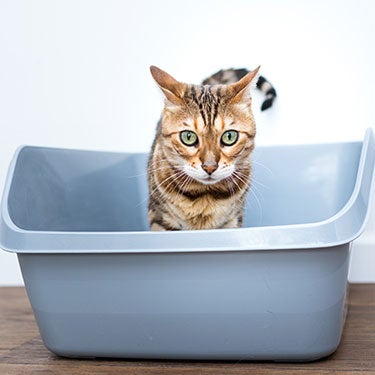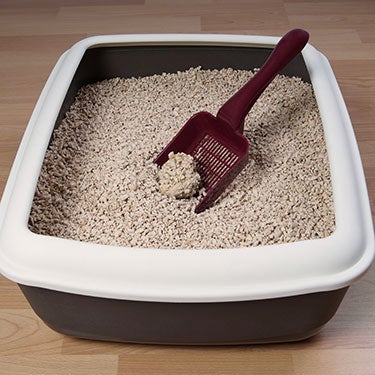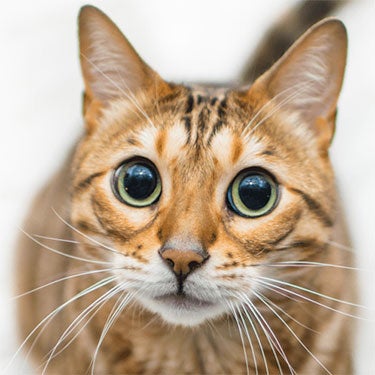How to Tell If Your Cat Has a UTI
Lots of time in the litter box is your first clue.Just like people, cats get sick, too. And one of the most common ways a kitty gets sick — and luckily, one of the most treatable ways if you catch it early enough — is feline lower urinary tract disease (FLUTD).1 A UTI (urinary tract infection (UTI) falls under the category of FLUTD.
As with people, an FLUTD can cause a kitty a lot of pain and discomfort, but often can be quickly fixed with a dose of antibiotics. But how can you tell if your cat is suffering and needs medical attention ASAP? Call a vet immediately if you notice any of the following:1
- Kitty is going to the litter box a LOT: A UTI makes her feel like she has to pee again. And again. And again.
- Kitty is straining to pee: Your cat might cry out because it hurts so much to pee. If you have a male cat, he might have developed a blockage in the urethra. This can be very bad for Kitty’s
health, since those toxins are building up in his little body. Get him to the vet, STAT. - There is blood in Kitty’s pee: Peeing blood is never good, for humans or cats.
- Peeing outside the box: Has Kitty suddenly gone free range? It might be that she has to go and can’t make it to the box in time.
- Woah, that stinks!: Is Kitty’s pee more pungent than usual? It could be a sign of an underlying UTI.2
- Kitty is licking a lot — like, a LOT — down there: Kitty isn’t just doing this for fun. It’s likely she’s trying to self-soothe in the only way she knows how.
Which cats are at risk for a FLUTD?
The answer to this is that a LOT of cats are at risk,1 especially if they’re indoor cats as the SPCA and many vets recommend. Here is the quick answer:
- Middle-aged cats
- Neutered cats (and we hope this means yours!)
- Overweight cats
- Cats who don’t get enough exercise
- Indoor-only cats
- Cats that eat only dry food (because they’re likely not getting enough water)
If it’s not a UTI, what could it be?
Even though your cat is showing all the signs of a UTI, it might not be his or her problem. There is a whole host of other issues with the same symptoms, such as:1
- Blockage of the urethra, as mentioned above. This happens in boy cats and can be fatal.
- Bladder stones
- A bladder infection (rather than a UTI)
- Cancer
- Spinal cord problems
Additional conditions could include:3
- Hyperthyroidism
- Diabetes
- Cystitis (this is sort of a catch-all phrase when the specific problem can’t be determined)
Because these symptoms have such wide-ranging and potentially fatal causes, any cat that’s in discomfort in the litter box needs to see his friendly neighborhood vet ASAP.
How will the vet diagnose my cat?
Once you bring your cat to the vet, she’ll determine (or try to) the cause of the issue. The tests include things such as: 1
- Urinalysis: The vet will either ask you to collect a urine sample using special litter, or keep your cat overnight and collect one himself. He’ll then examine the pee microscopically and perform a bacterial culture to see what the cause might be.
- X-rays: If this is a recurring problem and the vet suspects something beyond a UTI, an x-ray will reveal if there are any bladder stones or tumors.
- Ultrasound: This procedure can also help identify bladder stones or other issues.
- Biopsy: If a tumor is suspected, the vet will perform this during surgery or simply by inserting a catheter through the urethra.
Yes, all this is yucky, but important.
If your cat has a UTI, not only is she in pain — pain which a visit to the vet will help with enormously — but if ignored, a UTI can easily lead to severe kidney problems.4 And that can lead to huge vet bills — or worse, a trip to the rainbow bridge before Kitty’s time.
Learn to recognize these signs. If you spot them, it’s time to call the doctor.
Is Kitty feeling low? Give her a treat.
After a painful UTI episode, Kitty deserves lots of love and treats — and maybe some extra litter.
Join the Paw Points® program, and every purchase will earn you points. You can then redeem those points for free litter, coupons
1. Feline lower urinary tract disease (FLUTD). (n.d.). https://icatcare.org/advice/feline-lower-urinary-tract-disease-flutd
2. Urinary tract disease in cats. (2014). http://www.vetstreet.com/care/urinary-tract-disease-in-cats
3. Feline lower urinary tract disease. (n.d.). https://www.avma.org/public/PetCare/Pages/FLUTD.aspx
4. Common urinary & kidney ailments. (n.d.). https://www.vet.upenn.edu/veterinary-hospitals/ryan-veterinary-hospital/services/comprehensive-urology-care/common-urological-ailments




